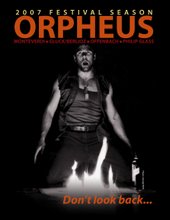Something old, something new
Opera has an ill-conceived reputation for being intellectually challenging, elitist, and overall intimidating here in America. And while anyone who has seen a production of Orpheus in the Underworld, Die Fledermaus, or any number of fine productions can tell you that's simply not true, the myth lingers on. A good director knows how to balance artistic creativity with accessibility. So, how can a director help an audience engage with a piece that's nearly 400 years old, composed before opera as we know it really existed? Director Christopher Alden has a plan. Having already directed the show with Opera North in Leeds, England, Alden is ready to tailor the production for Glimmerglass. This production of Monteverdi's L'Orfeo, marking the 400th anniversary year of its premiere in Mantua, Italy, uses a mixture of elements from 1607 and today.
Director Christopher Alden has a plan. Having already directed the show with Opera North in Leeds, England, Alden is ready to tailor the production for Glimmerglass. This production of Monteverdi's L'Orfeo, marking the 400th anniversary year of its premiere in Mantua, Italy, uses a mixture of elements from 1607 and today.
"It is very edgy," he said. "It's a piece about artists and art—at the core it's about what it means to be an artist. It's amazing how not a lot of things have changed between then and now- to survive as a composer, as a stage director, as a tenor or a baritone." Bringing an older opera up-to-date promises that there will be something in the production for everyone in the audience.
Something Old One of the challenges of producing such an old show is making the music sound like it did when it premiered. While this has a lot to do with the conductor's choices and knowledge of historical performance practice (ornamentation, tempi, accents, etc.), the most noticeable change is the type of instruments used. The other shows in the season have music rehearsals with a piano, but the Monteverdi will rehearse with a continuo ensemble of baroque keyboard instruments (such as a harpsichord) and stringed instruments. This is not because the piano wasn't invented until the 1800's, but rather because the interaction between instruments and voices in the early Baroque period more closely resembles that of today's jazz ensemble than a traditional orchestra. Although instruments like the recorder and trumpet have specifically written parts, the continuo instruments' score is like a blueprint or chord chart, leaving them free to improvise. This means that while the instruments are over 400 years old, each performance will be new and unique.
One of the challenges of producing such an old show is making the music sound like it did when it premiered. While this has a lot to do with the conductor's choices and knowledge of historical performance practice (ornamentation, tempi, accents, etc.), the most noticeable change is the type of instruments used. The other shows in the season have music rehearsals with a piano, but the Monteverdi will rehearse with a continuo ensemble of baroque keyboard instruments (such as a harpsichord) and stringed instruments. This is not because the piano wasn't invented until the 1800's, but rather because the interaction between instruments and voices in the early Baroque period more closely resembles that of today's jazz ensemble than a traditional orchestra. Although instruments like the recorder and trumpet have specifically written parts, the continuo instruments' score is like a blueprint or chord chart, leaving them free to improvise. This means that while the instruments are over 400 years old, each performance will be new and unique.
Something New
Set Designer Paul Steinberg and Costume Designer Doey Lüthi planned the props and costumes as fusion of faux 17th century fashion and contemporary styles. The assortment of furniture lends an eclectic atmosphere to the stage environment. The costumes run the gamut from classic Greek to frilled collars to patched jeans. "Eurydice is in this sort of Greeky-ish costume, but she also sort of looks like Courtney Love," Alden said.
Something "Borrowed"
Glimmerglass often co-produces shows with other companies. Co-producing a show means that the sets, props and costumes were designed with Opera North, Glimmerglass, and Norwegian Opera in mind, and the designers are at Glimmerglass working with the creative team. All of the sets and most of costumes are the same ones used in Opera North's production, with some alterations for new singers.
The cast will rehearse for four weeks before opening on July 28th. Until then, they'll be hard at work bringing Monteverdi's masterpiece 400 years into the future.
